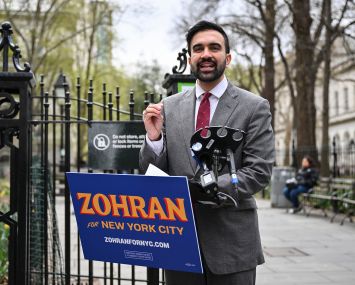 Few know Lower Manhattan better than Elizabeth H. Berger. A resident who has lived below Fulton Street since 1982, Ms. Berger, 50, signed on as the president of the Alliance for Downtown New York in 2007. Under her watch, the business improvement district has expanded bus and sanitation services while overseeing plans to connect 23 blocks south of the World Trade Center site to the rest of Manhattan and to thoroughly modernize Water Street’s commercial corridor.
Few know Lower Manhattan better than Elizabeth H. Berger. A resident who has lived below Fulton Street since 1982, Ms. Berger, 50, signed on as the president of the Alliance for Downtown New York in 2007. Under her watch, the business improvement district has expanded bus and sanitation services while overseeing plans to connect 23 blocks south of the World Trade Center site to the rest of Manhattan and to thoroughly modernize Water Street’s commercial corridor.
The Commercial Observer: What’s the difference between downtown New York and Lower Manhattan?
Ms. Berger: That’s something we think about a lot because brand is everything. There is a history of different definitions for downtown. I think downtown, historically, is associated with old New York, with cosmopolitan New York, and with alternative New York; I think Lower Manhattan has a much more fixed definition. There’s a notion of the financial district-plus. We’re a BID, as you know, and we have legislatively determined lines. Very specifically, they are south of Murray Street, south of Beekman Street, and the east side of Lower Manhattan. But for promotional, marketing and research purposes, we really say below Chambers Street.
In the past two months alone, the Alliance has taken part in Adopt a Geranium Day, installed new energy efficient signs along shuttle stops and offered a ‘Downtown Culture Pass’ for museums in Lower Manhattan. How do those offerings play a part in increasing real estate activity downtown?
We’re a business improvement district, and in the narrowest of definitions our job is to support commercial leasing. That’s something that has been broadly interpreted over the years. The BID was founded in 1995, at a time of high vacancy, when reasonable people really debated the future of Lower Manhattan as a market. The BID came together to provide supplemental services and also to reposition Lower Manhattan as a new kind of central business district. The initial concept was that tourism and residential conversion would support commercial real estate–and, boy, is that the practice now. What we see now is Lower Manhattan, really, as a global model for a 21st-century central business district… The programs you mentioned are about developing our constituencies to promote the strength of the community.
Tell me about some of the commercial leasing incentives the Alliance has lobbied for?
Well, when the BID was formed at a time of very high commercial vacancy, there really were two sets of initiatives. The first was to reduce commercial vacancy in obsolete buildings by encouraging residential conversion, and we were strong proponents of the 421G program. At the same time, we encouraged relocations through a variety of commercial leasing incentives collectively known as the CRP. Those incentives worked, but I think we review them from time to time so we were also advocates, at the time, for the sunset of 421G, when we thought that its goals had been achieved; although, it is something we would look at again.
What is coming into Lower Manhattan at the highest rate right now: business and employees, residential tenants, or entertainment venues?
That’s kind of apples and oranges.
Let’s talk about commercial first. We have seen relative stability in the number of employees in Lower Manhattan since the late ’90s, adjusted, of course, for the actual loss of desks on 9/11. Financial services remains our signature industry, but at 28 percent of our jobs they aren’t our only industry–and I think that’s good. I think one of the reasons that Lower Manhattan has either the lowest commercial vacancy rates or was tied for the lowest since 2008 is because of the diversification of our economy. Since 2005, we’ve had over 250 businesses relocate from midtown and midtown south and other areas to Lower Manhattan.
Interestingly enough, only 14 percent are financial services. We’ve seen a huge rise in professional services. The most significant sector of growth has been in creative services and also non-profits. We now have 60 media entities in Lower Manhattan. That’s everyone from American Lawyer to American Media and the Daily News signing a new lease… The letter of intent from Conde Nast is a transformative event, but it is building on a trend that started post 9/11–and that all ties into the explosion in the rental market.
I moved to Lower Manhattan in 1982 with about 10,000 pioneers. When the BID formed there were 14,000. On 9/11, 24,000, and now 55,000 people live in Lower Manhattan in 319 buildings.
Is there a stigma, perceived or otherwise, you believe Lower Manhattan needs to shed?
I think we’ve had a summer of very good news. We are the center of commercial development in New York City. We have 10 million square feet of Class A green, commercial office development on the World Trade Center site. We’re one of the fastest growing residential communities, and the entertainment, cultural and retail amenities that didn’t exist before are now here. We have the newest parks, some very exciting public developments with the Battery Maritime building, and the entrance to Governors Island, which was probably the biggest hit of the summer.
So, is that a no?
I think that’s old news. I’ve lived here for 28 years, and it’s just not true, and it hasn’t been for a very long time, that Lower Manhattan is a Monday through Friday, 9-to-5 community. One of the things I’ve done in the three years that I’ve been at the Alliance is banned the use of the word ’emerging.’ We’re not emerging. We’re here. And I think it’s worth saying that Lower Manhattan is really 400 years of innovation. We were the first live-work community in the New World. We were a trading post from the get-go, and our functionality has changed as the city has changed. In some ways we’re the past, present and future of New York.
Is there anything above 14th Street you’d like to yank down to Lower Manhattan?
Do I go above 14th Street? Lower Manhattan is already a commercial, residential and tourism destination of choice. We want to keep perfecting that model.
You can’t get Shake Shack down here.
Shake Shack is coming! It’s coming to what will be the new Conrad Hotel in Battery Park City.
So, case closed.
jsederstrom@observer.com


